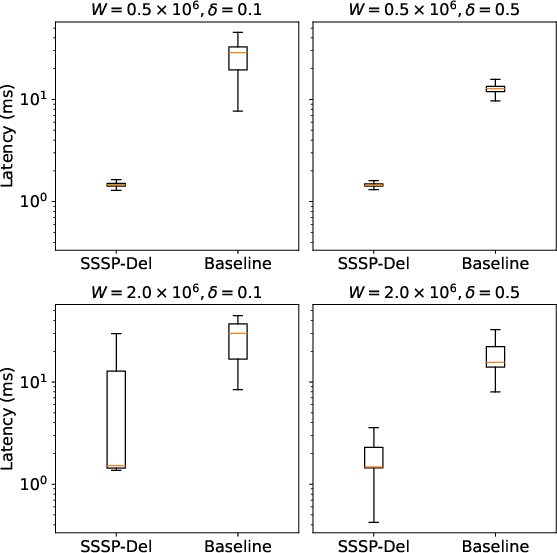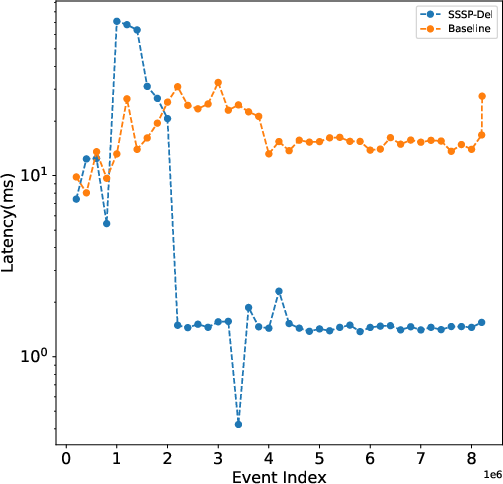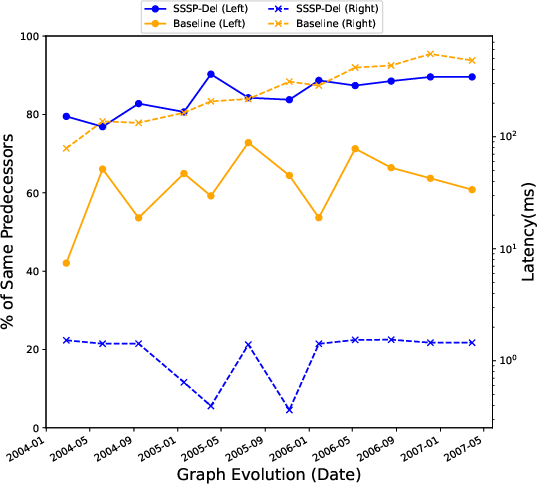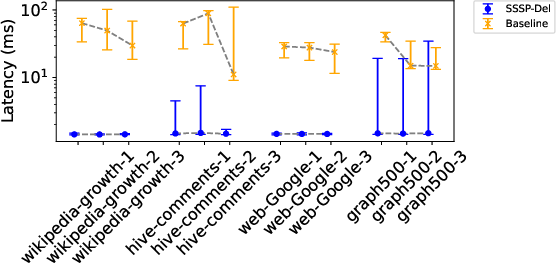- The paper introduces a vertex-centric, asynchronous algorithm for dynamically updating SSSP with efficient handling of both edge additions and deletions.
- It leverages a shared-nothing architecture to minimize centralized coordination, ensuring low query latency under high update frequencies.
- Results demonstrate superior scalability and stability compared to traditional methods, validating its robust performance on real-world graphs.
Overview of "SSSP-Del: Fully Dynamic Distributed Algorithm for Single-Source Shortest Path"
"SSSP-Del: Fully Dynamic Distributed Algorithm for Single-Source Shortest Path" introduces a vertex-centric, asynchronous, and fully distributed algorithm designed to address the Single-Source Shortest Path (SSSP) problem in dynamic graphs. The research primarily focuses on efficiently managing both edge additions and deletions within a distributed, shared-nothing architecture. The paper emphasizes the challenges associated with maintaining low-latency query answers while processing dynamic updates, providing a comprehensive evaluation of scalability and responsiveness on real-world and synthetic graphs.
Computational Framework
The algorithm leverages a vertex-centric, asynchronous, shared-nothing computational model to perform updates efficiently in distributed environments. Each vertex manages a local state and independently processes incoming topology changes and distance updates. The architecture supports on-demand querying and minimizes centralized coordination, thus enabling scalability.
Graph Representation and Execution
Vertices are represented with unique identifiers, maintaining state related to their neighborhood connections. The execution model ensures that each vertex handles input events, updates local states, and communicates changes asynchronously across the distributed network, following a first-in, first-out message ordering to guarantee consistency.
Topological Events Handling
Updates are ingested as streams of edge additions or deletions:
- Edge Additions: Propagate distance updates through the graph using principles derived from incremental-only algorithms.
- Edge Deletions: Involve a two-phase approach: invalidation and recomputation. Affected vertices are reset, and new shortest paths are recalculated by querying neighborhoods for alternative paths.

Figure 1: Comparison of query latency between SSSP-Del and the baseline, using the web-Google dataset under four different configurations: W={0.5M,2M}×δ={0.1,0.5}.
Algorithmic Details
Vertex Properties and Message Types
Vertices store essential properties, such as distance from the source, predecessor information, and successor sets. Communication occurs through different message types to update distances, propagate invalidations, and maintain tree structure consistency even in the presence of deletions.
Phased Approach to Deletions
Upon detecting an edge deletion, vertices undergo two sequential phases:
- Invalidation: Identifies and marks vertices affected by the deletion to invalidate their current shortest paths.
- Recomputation: Queries incoming edges to redefine shortest paths, ensuring minimal structural changes.

Figure 2: Comparison of query latency between SSSP-Del and the baseline, using the web-Google dataset with W=2M and delta=0.5. The vertical axis represents the query latency in milliseconds and is in log scale, and the horizontal axis is the event index after which the query is requested.
Evaluation and Results
The evaluation showcases the algorithm's effectiveness through various performance metrics:
Comparison with Existing Frameworks
The paper compares the proposed algorithm with existing frameworks such as GraphBolt and ReMo SSSP. The results highlight the advantages of SSSP-Del in handling fine-grained dynamic updates with lower query latency, bolstered by its asynchronous processing model that efficiently interleaves algorithmic and topological event handling.

Figure 4: Stability and Result Latency over time. The graph evolution (x-axis) is plotted against the percentage of vertices in the current result that had the same predecessor in the previous result (y-axis, left) and query latency (y-axis, right). Graph: Wikipedia-growth.
Conclusion
SSSP-Del effectively addresses the dynamic SSSP problem in large, evolving graphs, providing a scalable, distributed solution capable of handling high-frequency updates with low latency. Its design principles can be extended to broader applications in dynamic graph analytics, emphasizing the balance between algorithmic efficiency and adaptability to rapidly changing data landscapes. The research sets a foundation for future developments in dynamic graph processing, especially in distributed environments, where real-time processing and stability are critical.



